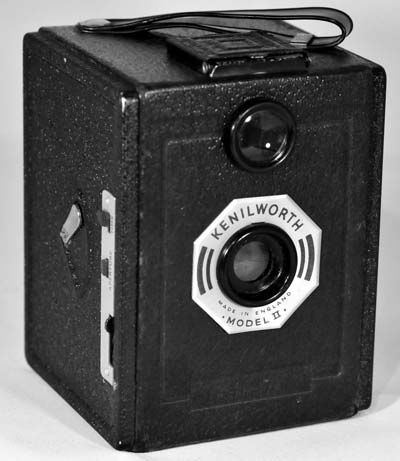Standard Kenilworth II
Specification

| Manufacturer | : | Standard |
|---|---|---|
| Produced | : | 1930 |
| Classification | : | Medium Format |
| Body Type | : | Pseudo twin lens reflex box |
| Construction | : | Metal, Cardboard, Plastic |
| Film Type | : | 120/620 |
| Film Width | : | 62mm |
| Image Size | : | 2¼ x 2¼ |
| No. of Images | : | 12 |
| Lens Type | : | Meniscus |
| Focal Length | : | 75mm |
| Focus Type | : | fixed |
| Focal Range | : | 7ft - Inf. |
| Aperture Type | : | Two stops |
| Apertures | : | f/16, f/22 |
| Shutter Type | : | Rotary |
| Shutter Speeds | : | T/I*(1/30s) |
| Size (w x h x d) | : | 95 x 120 x 87 mm |
| Weight | : | 372g |
| * Measured on this camera | ||
Art Deco Credentials
![]()
![]()
Acceptable: Modest and restricted
- Produced during the main Art Deco period.
- Octagonal face plate.
- Decorative arcs on face plate.
- Raised Square design on viewfinder.
Description
The Standard Kenilworth II was preceded by a simpler model with a round faceplate, a square viewfinder window and a simple instantaneous shutter. The Kenilworth II is a variable aperture model. It can be described as a pseudo twin lens reflex camera. It isn't a true TLR because the top lens is just part of the viewfinder and does not aid focussing. It has an identical mechanical design to the Coronet Twelve-20 variable aperture model.
The body construction is a metal frame and sides, with the front, back, top and bottom made of cardboard. It has a plastic box internally covering the mechanism. The reflex style brilliant viewfinder give a fairly clear image. The viewfinder is provided with a cover.
This model has a T/I shutter. The time mode is selected by pulling out a tab on the side. Another tab is used to select one of two apertures - f/16 or f/22. The depth of focus is quoted on a metal plate on the top of the camera as 8' 6" to infinity for f/16 and 7' 0" to infinity for f/22. It suggests using f/16 for bright sunlight and f/22 for brilliant sunlight. However, this would be using old film which would have had low ISO.
A lever on the side releases the other side of the camera to load the film. Film advance is by a knob on the side and exposures are counted using a red window which does not have a cover. The camera has a dual purpose spindle drive and will accept both 120 and 620 formats. It does not have a tripod mount. It comes with a poor quality plastic strap.
How to Use
This camera takes 120 film which is easily available. It has two aperture settings of f/16 and f/22. With a shutter speed of only 1/30 sec, make sure you brace the camera against your body or something solid and press the shutter smoothly to avoid camera shake.
If you don't want to bother with an exposure meter, follow the guide shown. It is based on the 'Sunny 16' rule. Film is so forgiving and will produce acceptable results even when over-exposed by 2 or 3 stops or under-exposed by 1 stop.
The table shown assumes the shutter speed is about 1/30s.
The table also assumes that the sun is at least 30 degrees above the horizon - that's 10am - 5pm on a summers day in the UK.
Remember that the exposure guide in the manual may not be helpful as it is based on the use of old film with a low ISO value.
Using ISO 100/125 film - shutter speed 1/30s
| Weather Conditions | Shadow Detail | Aperture | Exposure |
|---|---|---|---|
 Sunny SunnySnow/Sand | Dark with sharp edges | f/22 | +2 Stop Overexposed Acceptable |
 Sunny Sunny | Distinct | f/22 | +1 Stop Overexposed Acceptable |
 Slight Overcast Slight Overcast | Soft around edges | f/22 | Good |
 Overcast Overcast | Barely visible | f/16 | Good |
 Heavy Overcast Heavy Overcast | None | f/16 | -1 Stop Underexposed Acceptable |
 Open Shade Open Shade/Sunset | None | f/16 | -2 Stops Underexposed Not Acceptable |